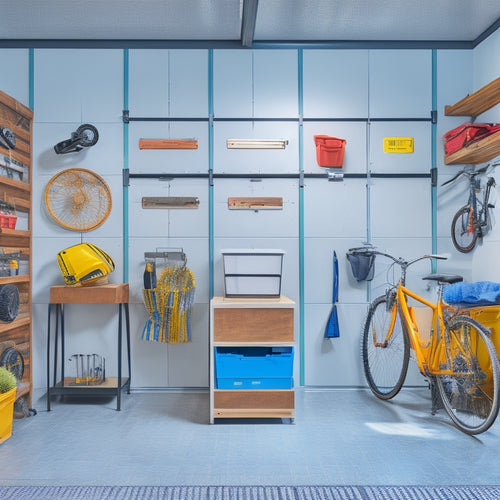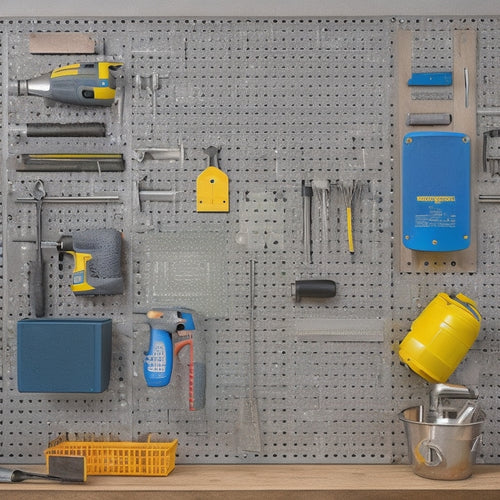
Why DIY Projects Fail Without Proper Planning Tools
Share
When you initiate a DIY project without proper planning tools, you're setting yourself up for failure. You'll likely lack clear project objectives, leading to costly mistakes and wasted resources. Inadequate resource allocation planning will cause supply shortages, overworked team members, and delays. Unrealistic timelines will result in rushed decisions and compromised quality. Insufficient budgeting and poor task assignment will only add to the chaos. You'll overlook essential resources, underestimate material costs, and overestimate your skill level. Without a solid plan, your project will spin out of control. Discover the tools and strategies you need to get back on track and guarantee your DIY project's success.
Key Takeaways
• Lack of clear project objectives leads to costly mistakes, wasted resources, and delays in DIY projects.
• Inadequate resource allocation planning causes supply shortages, overworked team members, and delayed project progress.
• Unrealistic timeline expectations result in rushed decisions, compromised quality, and project abandonment.
• Insufficient budgeting and cost tracking lead to financial crises, project debt, and abandonment.
• Poor task assignment and delegation cause project delays, inefficiencies, and a lack of accountability among team members.
Lack of Clear Project Objectives
When diving into a DIY project without clear objectives, you're more likely to encounter costly mistakes, wasted resources, and frustrating delays, ultimately turning your exciting venture into a stressful nightmare. This is because unclear objectives lead to confusion, miscommunication, and a lack of direction. Without well-defined goals, you and your team will struggle to stay focused, making it challenging to allocate resources efficiently.
Objective setting is vital in DIY projects. It enables you to define what needs to be accomplished, prioritize tasks, and allocate resources effectively. When your objectives are clear, you can align your goals, ensuring everyone involved is working towards the same outcome.
A clear project vision is essential for team understanding, allowing each member to comprehend their role and responsibilities. This, in turn, fosters a sense of accountability, ensuring everyone is committed to achieving the project's objectives.
Inadequate Resource Allocation Planning
You risk derailing your DIY project if you fail to allocate resources effectively, as unclear objectives often lead to poor resource planning, and now it's time to examine how inadequate resource allocation planning can further compound the problems. This oversight can lead to resource allocation pitfalls, such as underestimating material costs, misallocating labor, and neglecting equipment needs.
| Resource | Allocation Pitfalls | Planning Tool Benefits |
|---|---|---|
| Materials | Underestimating costs, running out of supplies | Accurate cost estimates, automated supply tracking |
| Labor | Misallocating tasks, overworking team members | Task assignment optimization, team workload balancing |
| Equipment | Neglecting equipment needs, rental delays | Equipment scheduling, rental coordination |
Unrealistic Timeline Expectations Set
Establishing overly optimistic timeline expectations can lead to a DIY project's downfall, as it sets the stage for rushed decisions, costly rework, and compromised quality. You may be enthusiastic to complete your project, but overestimating your capabilities can lead to burnout and mistakes. To avoid this, take a step back and reassess your timeline.
Here are some common mistakes to avoid:
-
Underestimating task complexity: Don't assume that tasks will take less time than they actually will. Break down complex tasks into smaller, manageable chunks to get a more accurate estimate.
-
Not accounting for contingencies: Life can be unpredictable, and unexpected setbacks can occur. Build in buffers to your timeline to accommodate unexpected delays.
-
Overcommitting yourself: Don't take on more than you can handle. Be realistic about your availability and energy levels.
- Not leaving room for review and revision: Rushing through a project can lead to mistakes and oversights. Leave time for review and revision to guarantee quality.
Insufficient Budgeting and Cost Tracking
After reassessing your timeline, it's equally important to take a hard look at your budget, as insufficient financial planning can quickly turn a DIY project into a financial nightmare. Without a clear understanding of your expenses, you risk overspending, which can lead to project abandonment or even debt.
To avoid this, establish a realistic budget that accounts for all necessary materials, tools, and labor costs. Implement cost tracking to monitor your expenses and identify areas where you can cut back. Effective budgeting strategies, such as the 50/30/20 rule, can help you allocate your resources wisely. Allocate 50% of your budget to essential expenses, 30% to non-essential but important items, and 20% to discretionary spending.
Poor Task Assignment and Delegation
Failing to delegate tasks effectively can lead to project delays, inefficiencies, and even burnout, as a single person may be shouldering too much of the workload. When you don't assign tasks correctly, you may end up doing everything yourself, which can be overwhelming and lead to poor quality work. This is often due to ineffective supervision, where you may not be providing clear guidance or oversight to team members.
Here are some common mistakes to avoid when assigning tasks:
-
Unclear instructions: Failing to provide detailed instructions can lead to misunderstandings and mistakes.
-
Lack of accountability: Not setting clear deadlines or expectations can lead to procrastination and delays.
-
Inadequate resources: Not providing team members with the necessary tools or training can lead to poor quality work.
- Inequitable workload: Assigning too much work to one person or not distributing tasks fairly can lead to burnout and resentment.
Ineffective Communication and Collaboration
When you're working on a DIY project without proper planning tools, you'll likely struggle with ineffective communication and collaboration.
You'll find that you and your team members aren't on the same page, which is often due to a lack of clear goals.
As a result, your team's efforts will be misaligned, leading to wasted time and resources.
Lack of Clear Goals
Without clear goals, you'll likely find yourself wandering aimlessly through your DIY project, wasting time and resources on unnecessary tasks. This lack of direction can lead to frustration, confusion, and ultimately, project failure.
To avoid this, it's crucial to establish well-defined goals from the outset.
This involves:
-
Defining specific objectives: Identify what you want to achieve and prioritize your tasks accordingly.
-
Establishing measurable outcomes: Quantify your goals to track progress and stay motivated.
-
Setting realistic timelines: Create a schedule that allows for flexibility and adaptability.
- Assigning accountability: Identify who's responsible for each task to make sure everyone is on the same page.
Misaligned Team Efforts
More than 60% of DIY projects suffer from misaligned team efforts, resulting in duplicated tasks, costly rework, and delayed completions. These issues can be avoided by implementing effective communication and collaboration strategies.
You've probably experienced it yourself - team members working on the same task without realizing it, or worse, working on different tasks that don't align with the project's goals. This is often due to poor team dynamics, where individuals don't understand their roles or responsibilities, leading to coordination challenges.
To avoid these issues, establishing clear communication channels and defining each team member's tasks and expectations is crucial. This can be achieved by using project management tools, such as Kanban boards or Gantt charts, to visualize the project's progress and identify dependencies.
Regular team meetings and check-ins can also help ensure everyone is on the same page. By streamlining your team's efforts, you can avoid duplicated work, reduce rework, and complete your DIY project on time and within budget.
Failure to Identify Potential Roadblocks
When you commence on a DIY project without proper planning tools, you're more likely to overlook potential roadblocks that can derail your project.
You might set unrealistic timelines, fail to account for resource constraints, or underestimate material costs, all of which can lead to costly delays and rework.
Unrealistic Timelines Set
You set yourself up for disappointment by establishing unrealistic timelines that fail to account for potential roadblocks, ultimately leading to project delays and frustration. When you don't leave room for unexpected setbacks, you're more likely to fall behind schedule, causing stress and demotivation.
Effective time management and project planning require a realistic understanding of the time and resources needed to complete each task. To avoid setting yourself up for failure, consider the following:
-
Pad your timeline: Add 10-20% to your estimated project timeframe to account for unexpected delays.
-
Identify potential roadblocks: Think about what could go wrong and develop contingency plans to mitigate their impact.
-
Break tasks into smaller chunks: Divide complex tasks into smaller, manageable pieces to help you stay on track.
- Regularly review and adjust: Regularly assess your progress and adjust your timeline as needed to stay on track.
Unrealized Resource Constraints
Resource constraints can quietly sabotage your DIY project, as overlooking essential tools, expertise, or materials can bring progress to a grinding halt and turn a well-intentioned endeavor into a frustrating nightmare.
You might assume you have everything you need, but neglecting to account for potential roadblocks can lead to costly delays and budget blowouts.
Effective budget management is vital in DIY projects. You must accurately estimate the cost of materials, labor, and equipment rental. Failure to do so can result in financial strain, forcing you to cut corners or abandon the project altogether.
Time constraints are another crucial element to keep in mind. You may underestimate the time required for each task, leading to a project that drags on for months, exhausting your energy and motivation.
To avoid these pitfalls, take the time to assess your resources thoroughly. Identify potential bottlenecks and develop contingency plans to mitigate their impact. By doing so, you'll be better equipped to manage your budget and time constraints, ensuring your DIY project stays on track and reaches its full potential.
Unforeseen Material Costs
Hidden material costs can lurk in the shadows, waiting to derail your DIY project's budget and timeline, particularly if you overlook examining your plans for potential roadblocks. Without a clear understanding of the materials required, you may encounter unexpected delays and hidden fees that can swiftly accumulate. This can be particularly problematic when operating within a constrained budget or timeline.
To avoid these costly surprises, carefully planning and budgeting for all materials needed is crucial. Here are some common areas where hidden material costs can arise:
-
Specialized tools: You may need to purchase or rent specialized equipment to complete specific tasks, increasing your overall expense.
-
Shipping and handling: Remember to consider the expense of shipping and handling for materials, especially if you're making online purchases.
-
Material upgrades: You may need to upgrade materials to adhere to local building codes or regulations, leading to additional costs.
- Waste and excess: Anticipate material wastage and excess, which can accumulate rapidly if not accounted for.
Inadequate Progress Monitoring Systems
Without a clear system in place, DIY project timelines often slip, and tasks start to overlap, making it difficult to identify which stage of the project is causing the bottleneck. This is where inadequate progress monitoring systems come into play.
You might think you're on track, but without a system to track your progress, you're flying blind. You won't be able to pinpoint which tasks are taking longer than expected or identify areas where you need to allocate more resources.
Effective progress tracking is essential to staying on schedule and within budget. By implementing a monitoring system, you'll be able to break down your project into manageable tasks, set realistic deadlines, and track your progress along the way. This will enable you to make adjustments as needed, ensuring you stay on course.
With a clear picture of your project's progress, you'll be able to identify potential roadblocks before they become major issues, saving you time, money, and stress in the long run. By prioritizing progress tracking and monitoring systems, you'll be better equipped to overcome common DIY project pitfalls and achieve success.
Unrealistic Skill Level Expectations
When you take on a DIY project, you're likely to encounter tasks that require specific skills.
However, you often overestimate your abilities, thinking you can handle tasks that are beyond your skill level.
This unrealistic expectation can lead to frustration and mistakes, so it's crucial to take an honest assessment of your skills before starting a project.
Overestimating Abilities Leads
Taking on a DIY project without honestly evaluating your skills can lead to unrealistic expectations about your ability to complete it successfully. You might assume you can tackle a complex task without sufficient experience or training, only to find yourself overwhelmed and struggling to make progress. This is especially true when you're underestimating challenges and neglecting improper planning.
Here are some common consequences of overestimating your abilities:
-
Inadequate preparation: You mightn't gather the necessary materials or tools, leading to delays and setbacks.
-
Poor time management: You might underestimate the time required to complete tasks, resulting in a rushed and subpar finish.
-
Lack of patience: You might become frustrated with the process, leading to mistakes and a higher risk of abandonment.
- Insufficient budgeting: You mightn't allocate enough funds for unexpected expenses, causing financial strain.
Lack of Honest Assessment
Lack of Honest Assessment
You set yourself up for failure by assuming you possess skills you've never actually developed or demonstrated. This unrealistic self-assessment can lead to a DIY project disaster. It's crucial to take a step back, reflect on your abilities, and honestly evaluate your skills.
| Skill | Reality Check |
|---|---|
| Carpentry | Have you built a piece of furniture before? |
| Electrical Work | Have you wired a light fixture or outlet? |
| Plumbing | Have you fixed a leaky faucet or toilet? |
| Painting | Have you painted a room or furniture piece? |
| Masonry | Have you laid bricks or tiles before? |
Take the time to reflect on your skills and experience. Be honest with yourself about what you can and cannot do. If you're unsure, consider seeking guidance or taking a class to learn the necessary skills. Remember, self-awareness is crucial to avoiding DIY project failures. By acknowledging your limitations, you can plan accordingly, delegate tasks, or seek help when needed. This honest evaluation will save you time, money, and frustration in the long run.
No Contingency Planning in Place
You often find yourself scrambling to adjust to unexpected setbacks because you didn't establish a backup plan before starting your DIY project. This lack of contingency planning leaves you with reactive solutions, rather than proactive planning. When things go wrong, you're left playing catch-up, wasting valuable time and resources.
To avoid this, it's crucial to prepare for potential setbacks before they occur. Here are a few ways to do so:
-
Identify potential risks: Think about what could go wrong and how you'll mitigate those issues.
-
Create a backup plan: Develop a plan B (or C, or D) in case your initial approach fails.
-
Set aside a contingency fund: Allocate extra resources for unexpected expenses or setbacks.
- Prioritize flexibility: Be prepared to adjust your plan as needed to stay on track.
Frequently Asked Questions
How Can I Ensure All Project Stakeholders Are on the Same Page?
As you begin your DIY project, you're the conductor of an orchestra, ensuring harmony among stakeholders. You'll achieve this by implementing effective communication strategies, fostering stakeholder engagement, and aligning expectations to guarantee everyone's on the same page.
What's the Best Way to Prioritize Tasks When Facing a Tight Deadline?
When facing a tight deadline, you'll prioritize tasks by focusing on time management and task delegation, allocating resources effectively, and considering deadline extension if necessary, to guarantee efficient project completion.
Can DIY Project Management Tools Replace Professional Project Managers?
You can leverage project management software to boost efficiency, but it can't replace a professional project manager's expertise in handling complex DIY project challenges and team dynamics, ensuring successful outcomes.
How Often Should I Review and Adjust My Project Plan?
'As you navigate your project's twists and turns, regularly review and adjust your plan every few weeks to guarantee you're on track, adjusting resource allocation and flexing to changes, keeping your project timeline on course.'
What's the Ideal Team Size for a DIY Project to Avoid Chaos?
When assembling your DIY team, you'll want to aim for 3-5 members to maintain effective team dynamics and communication strategies, allowing for efficient task delegation and time management, ensuring a harmonious and productive project environment.
Related Posts
-

Modular Tool Storage Systems for Small Spaces
You can optimize your small workspace by leveraging modular tool storage systems that intelligently employ vertical s...
-

3 Pro Garage Organization Ideas to Try Now
You can alter your garage from cluttered chaos to organized oasis with three pro garage organization ideas. First, op...
-

How to Hang a Pegboard in 5 Easy Steps
You'll hang a pegboard in 5 easy steps by first preparing the wall, ensuring it's sturdy and free of obstructions. Ne...


